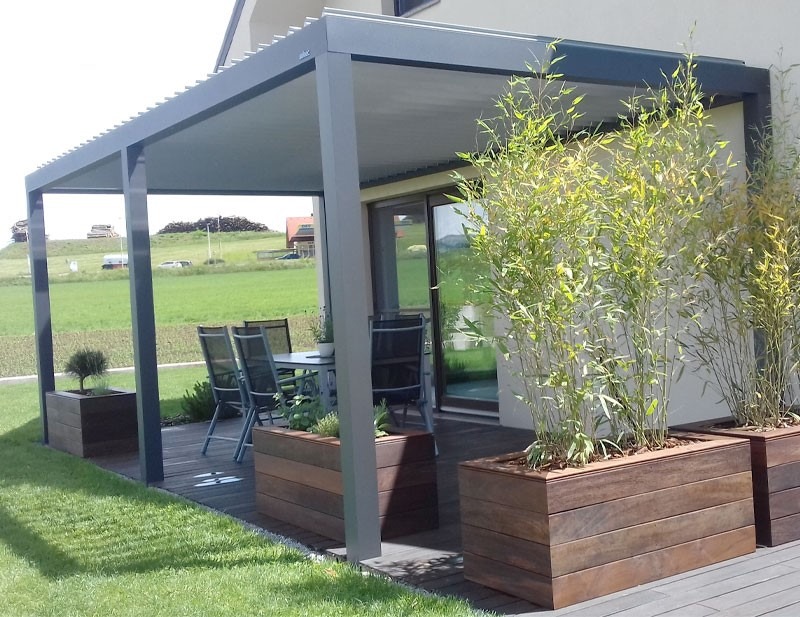
Pergola Covers. The Best Covers for Pergolas.
The very nature of a regular pergola doesn’t necessarily mean that you’ll have a solid roof over your head – or any sort of roof, in that regard. This is where various pergola covers come in, and there’s a big variety of those, too. For example, pergola covers can be made from cloth, wood, metal, plastic, or even the plants.
Our example in all of these cases is a regular pergola with a few beams instead of the complete roof. This is a relatively common pergola example that creates an outdoor area for a number of different purposes but has basically no protection from most of the harsher weather conditions like rain, snow, and so on.
All of the covered pergola ideas can be basically split in two big categories: the ones that provide shade (but are not completely waterproof), and the ones that are waterproof in the first place.
Pergola covers that focus on shade
Most of the cases in this category are much easier to install, but are less effective when it comes to protecting the insides of a pergola from something like heavy rain.
Our first idea of a pergola shade cover is to grow vines as a makeshift cover. While this idea, if treated right, can become a beautiful and functional addition to your pergola and your backyard, there are a number of potential problems that you have to keep in mind beforehand.
For example, most of the time vines and plants are not capable of protecting you from rain, so it’s all about shade. Even grape vines with a lot of foliage would be able to protect you from a medium-sized rain, at most. There’s also the fact that you’ll have to be careful with the plant of your choice, some of the vines that are fit as a pergola roof can be an outright nightmare to keep in the shape and the place you want it to be.
The next pergola cover in this category is a stationary canopy (heavy-duty outdoor fabric is the one that’s used the most in these cases). All of the examples below are DIY, of course, and require only a small amount of effort to install and use. There’s a few ways that you can attach your outdoor fabric to the pergola:
- Attach the fabric to the rafters from inside of a pergola;
- Attach the fabric to the pergola from the above without stretching it too much;
- Attach the fabric from above with pulling the fabric tight between the rafters.
There’s also another example of a pergola shade cover that can be put together with all of these stationary canopies, and it’s all about buying a pergola canopy kit. It’s relatively similar to the last method of working with a regular fabric as your canopy, the only difference is that this fabric would be much easier to attach to the sides of your pergola by using grommets from the canopy kit in question.
Since there is a stationary canopy, it’s only fair to mention that there are also retractable canopies that you can use. As with the stationary covered pergola ideas, retractable canopies can be either DIY (using any of the plethora of guides all over the internet) or by using the pre-made retractable canopy that you can buy in a handy kit that should make the installation process that much easier.
This concludes the list of pergola covers that are more about shade, and most of them are not waterproof at all. In this context it’s only logical to move on to the waterproof covers.
Waterproof pergola covers
One of the simplest choices for a waterproof pergola cover are shade sails, surprisingly enough. Using shade sail as your pergola cover would be able to create installation kit that’s sold separately from the shade sail itself most of the time. Shade sails themselves are made with the shade and rain protection in mind, that’s why they make a nice alternative as a pergola cover.
Another option when it comes to waterproof pergola covers is to attach an actual solid roof to your pergola, it can be made from tin, steel, plastic, wood, or a number of other materials. This option is somewhat more expensive than the previous ones, but it does provide a complete protection from the harsher weather conditions, and if you’ll make a small slope when installing your roof, then the water a waterproof cover for your pergola, but you’ll need to invest extra into the shade sail would not be staying on your roof, either.
Pergola Agava
All of the examples of pergola covers above have their own advantages and disadvantages, but all of them are suitable for your regular pergola nonetheless. Luckily enough, there is an option that doesn’t need covers in the first place, and it’s called pergola Agava.

Pergola Agava is a modern type of pergola that features an adjustable roof with rotating slats that can both provide you more sun and free air when you need it, and protect you from rain or snow if there’s a need in that – all thanks to the bioclimatic nature of the pergola Agava, among other advantages.
